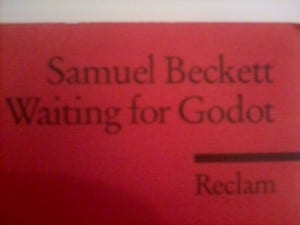Today we had a session at the Lincoln Grandstand, which has become our performance site. We were given one task to carry out and a few questions to ponder and note down our thoughts whilst on site.
The task was – To seek out traces, archaeological traces of other (former) visitors and occupants. This task is modified from a question of the same wording found in the following source ((Pearson, M (2010) Site-Specific Performance Palgrave Macmillan: London. Page 21))
The questions were – How am I affected? What do I feel? What do I perceive? What do I experience? How far is this informed by predispositions and previous experience? To what do I attend – natural landscape, built environment, sky as well as land, night as well as day and in foul weather as well as fare? Upon my return, how do I reconstitute ‘there’ here? These questions were taken from the following source ((Pearson, M (2010) Site-Specific Performance Palgrave Macmillan: London. Page 22))
When I first got on site I began to look for any traces of people being at the site at any period in time. The following pictures are what I documented whilst carrying out this task.
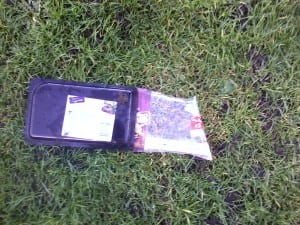 This first photograph is of some rubbish left by a person who was on the site.
This first photograph is of some rubbish left by a person who was on the site.
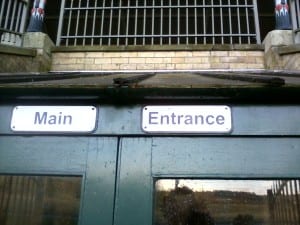 This photograph of the sign ‘Main Entrance’ would only need to be in place if people use the site. Because it is in place, people clearly are using the site.
This photograph of the sign ‘Main Entrance’ would only need to be in place if people use the site. Because it is in place, people clearly are using the site.
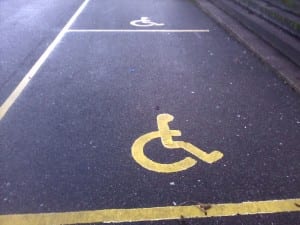 This photograph is of disabled parking bays, which is strong evidence that this site is in use.
This photograph is of disabled parking bays, which is strong evidence that this site is in use.
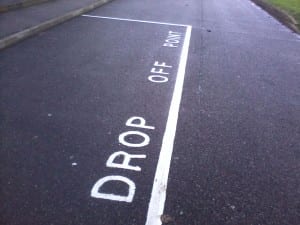 This photograph of a ‘Drop Off Point’ is another piece of evidence to suggest that the site is regularly used.
This photograph of a ‘Drop Off Point’ is another piece of evidence to suggest that the site is regularly used.
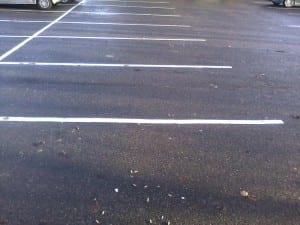 Similar to the two photographs above, this is an image of the car park. If the site was not in use why would there be a car park?
Similar to the two photographs above, this is an image of the car park. If the site was not in use why would there be a car park?
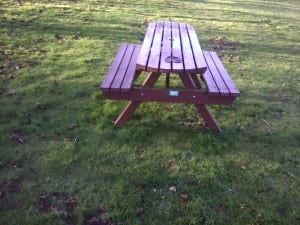 This is a photograph of a bench found on site, so whoever it was that erected the bench is trying to make the site appealing for visitors who may use the site for a picnic.
This is a photograph of a bench found on site, so whoever it was that erected the bench is trying to make the site appealing for visitors who may use the site for a picnic.
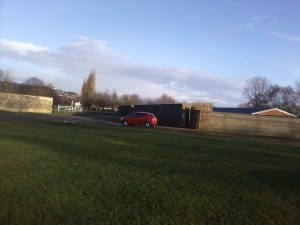 This final image is of a visitor to the site’s car. This is the strongest piece of evidence that there are other people beside myself and our class using the site.
This final image is of a visitor to the site’s car. This is the strongest piece of evidence that there are other people beside myself and our class using the site.
The above photographs are of my first attempt at seeking out traces, archaeological traces of other (former) visitors and occupants. The first photograph showing the remains of what was left by someone on site leading up to the last photograph of someone on site. However, it wasn’t until I really started to search closer on the actual site itself that I realized there were clearly traces of others who had been there before me. The following photographs are what I documented of these new traces.
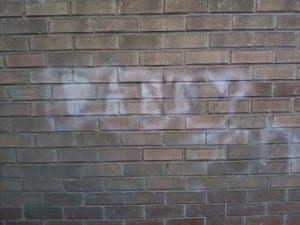 Someone called ‘Danny’ from what I could make out was leaving his mark of being on site.
Someone called ‘Danny’ from what I could make out was leaving his mark of being on site.
 Next to Danny’s mark was the mark of ‘Jenny’ who had also been on the site.
Next to Danny’s mark was the mark of ‘Jenny’ who had also been on the site.
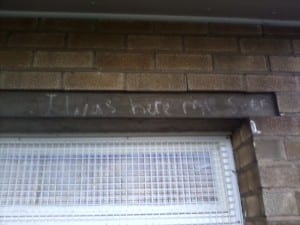 An anonymous drifter perhaps? Whoever they were, they too left their mark on the site.
An anonymous drifter perhaps? Whoever they were, they too left their mark on the site.
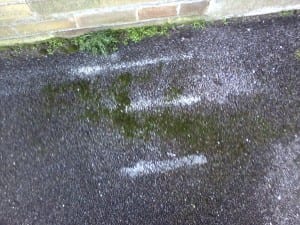 Possibly builders leaving a mark of where underground wires are? They too left their mark on site.
Possibly builders leaving a mark of where underground wires are? They too left their mark on site.
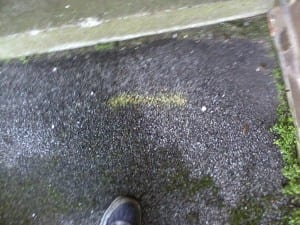 Could this mark have been left by the same person who left the above mark?
Could this mark have been left by the same person who left the above mark?
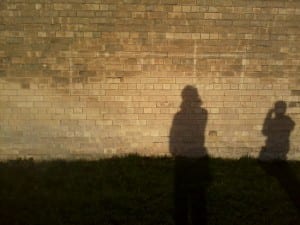 Maybe some children chalked up a goal on the wall? They left their mark on the site as well.
Maybe some children chalked up a goal on the wall? They left their mark on the site as well.
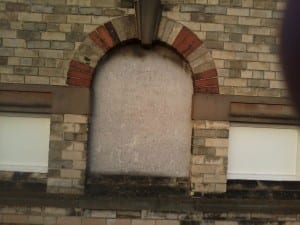 Although I could not make out the names on the stone, this photograph is of a memorial stone placed within the site’s architecture. I presume that the names are those who were most involved in erecting the site.
Although I could not make out the names on the stone, this photograph is of a memorial stone placed within the site’s architecture. I presume that the names are those who were most involved in erecting the site.
After discovering the traces shown above I had some answers to the questions we had been asked.
How am I affected? I was inspired by these traces of previous visitors. I see them as a way of trying to be remembered, as if by leaving your mark on a site you are some how leaving a memory of yourself being there for others to see.
What do I feel? I felt that, like those who came before me, through the photographs I had taken at the site, I was leaving my mark at the site as well. The photographs are evidence that I had been at the site as well.
What do I perceive? There were lots of visual marks of past visitors, it was as if I was in an art gallery looking at other peoples’ signatures.
What do I experience? I experienced 2 strong feelings. The first was the thought that people wanted to be remembered. As if the goal wasn’t to live forever, but instead to create a lasting memory in other people’s minds, even those who had never met them. The second was that as I was taking more photographs, and gathering more evidence that I had been to the site as well, I was becoming amalgamated with those who had been before me, as if we were all one collective. We were all drifters and this was our site.
How far is this informed by predispositions and previous experience? I had never been to the site before, I had only heard a small part of the site’s history but nothing specific about the site in terms of it’s aesthetics, so I went with as open a mind as I could.
To what do I attend – natural landscape, built environment, sky as well as land, night as well as day and in foul weather as well as fare? I struggled with this question initially, but after finding all of the traces on the walls, many of which had already stood the test of the weather, I decided that it didn’t matter what natural or man made circumstances occurred on site, only that these traces were not disturbed.
Upon my return, how do I reconstitute ‘there’ here? For this I drew a marking on a piece of paper which read ”Jonny Was Ere’ to illustrate my idea that people leave markings to be remembered.
I feel that investigating the 2 concepts of 1) leaving your own mark on the site and 2) becoming one with those who came before you will enable me to produce a performance on the site, for the site and inspired by the site.
